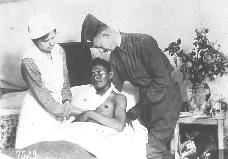

Health services administered by the Office of Indian Affairs were most often poorly equipped to combat the serious cases of tuberculosis, trachoma, smallpox, and other contagious and infectious diseases on Indian reservations during the late 19th- and early 20th-centuries. The federal government's program of assimilation of Native Americans into white culture dominated reservation health care during this period.
Native American traditions with regard to home, child-rearing, and treatment of illness were disregarded in favor of white ways. For this reason, health care was considered most effective when administered off the reservation. This meant removal of patients from their communities, as in the case of Alaskan Native patients of the Morningside Hospital in Portland, Oregon.
World War I briefly refocused United States government resolve overseas, where a number of Native Americans served the U.S. in armed combat. Some were wounded and treated at U.S. Army base hospitals in France, like the two men shown here.

[1138x683 8-bit grayscale JPEG, 180143 bytes]
(From left to right) Dr. H. W. Coe, Native Alaskan, Government Inspector.
The Insane of Alaska:
For Sixteen Years Administered Under the Department of the
Interior at Morningside Hospital, Portland, Oregon.
1920 catalog of the facility, p. 10.
The Care of the Insane of the Territory of Alaska, Addressed to the Governor and Legislature of the Territory of Alaska, January 17, 1925. Administered by the Department of the Interior at Morningside Hospital, Portland, Oregon. 1925. Many of the patients were Native Alaskans. [another catalog from Morningside Hospital, not shown in online exhibition].

[715x497 8-bit grayscale JPEG, 50205 bytes]
Wounded Choctaw soldier in the U.S. service is attended.
World War I, U.S. National Red Cross Hospital No. 5,
Auteuil, France, c.1917-1918
[photographic reproduction/Images from the History of Medicine (IHM)].

[637x516 8-bit grayscale JPEG, 42953 bytes]
Choctaw patient, World War I.
U.S. Base Hospital No.41, Paris,
France, c.1917-18
[photographic reproduction/Images from the History of Medicine (IHM)].

[640x518 8-bit grayscale JPEG, 42704 bytes]
Cherokee patient, World War I.
U.S. Base Hospital No.41, Paris,
France, c.1917-18
[photographic reproduction/Images from the History of Medicine (IHM)].

[722x389 8-bit grayscale JPEG, 47450 bytes]
Public Health Service physician with his car stuck
in the mud on an Indian reservation,
c.1910-1920
[photographic reproduction/Images from the History of Medicine (IHM)].


[left: 487x786 24-bit color JPEG, 53914 bytes
right: 540x847 8-bit grayscale JPEG, 67587 bytes]
Indian Babies:
How to Keep Them Well, Office of Indian Affairs, 1916.
Pamphlet illustrates assimilationist philosophy of government
care at this time.

[721x568 8-bit grayscale JPEG, 68570 bytes]
Burning of a Navajo Hogan that had been occupied by a
victim of smallpox,
near Indian Wells, Leupp Indian Reservation, Arizona,
c.1890-1910. [Photographic reproduction:
From collections of the National Archives and Records Administration.]

[647x406 8-bit grayscale JPEG, 48913 bytes]
Contagious and Infectious Diseases Among the Indians,
U.S. Senate Document, 1913.
Native American victims of Trachoma.
![]() Health Care to Native Americans Home Page
Health Care to Native Americans Home Page
![]() Exhibition and Public Programs Home Page
Exhibition and Public Programs Home Page
![]() History of Medicine Home Page
History of Medicine Home Page